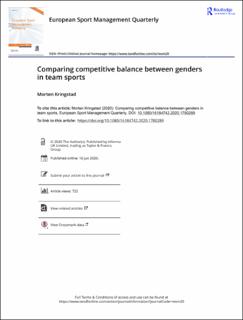| dc.contributor.author | Kringstad, Morten | |
| dc.date.accessioned | 2021-02-04T14:07:45Z | |
| dc.date.available | 2021-02-04T14:07:45Z | |
| dc.date.created | 2021-01-16T16:10:05Z | |
| dc.date.issued | 2020 | |
| dc.identifier.citation | European Sport Management Quarterly. 2020, . | en_US |
| dc.identifier.issn | 1618-4742 | |
| dc.identifier.uri | https://hdl.handle.net/11250/2726243 | |
| dc.description.abstract | Research question: Interest in women’s team sports has increased over time. However, there is still little research comparing competitive balance between genders in the bigger sports leagues. Against this background the main research question is whether there are systematic differences in competitive balance between the genders among the bigger sports leagues.
Research methods: The analysis involves football (soccer), handball and basketball leagues for the period 2007/08–2016/17 (14 leagues and 135 observations) and is based on quantitative methods. Competitive balance is a multidimensional concept, and this paper separately measures win dispersion, performance persistence and prize (here: championship winner) concentration.
Results and findings: In football (soccer), win dispersion is strongly significantly weaker for women’s leagues compared to their respective men’s leagues, while the results for the other dimensions are mixed. Generally, the level of competitive balance seems weak in women’s football (soccer) and in handball. For the latter, there is little difference in competitive balance between the genders. In basketball, the strong significant results for performance persistence suggest that the Women’s National Basketball Association (WNBA) is more balanced than the NBA.
Implications: The level of competitive balance in women’s football in Europe looks weak, also compared to the women’s football in North America. If this leads to competitive balance problems (i.e. lower attendance, ceteris paribus) among women’s football in Europe, governing bodies should consider traditional regulations to promote equalization of sporting quality and/or to adjust the framework of the game to better fit women’s physiques. | en_US |
| dc.language.iso | eng | en_US |
| dc.publisher | Taylor & Francis | en_US |
| dc.rights | Attribution-NonCommercial-NoDerivatives 4.0 Internasjonal | * |
| dc.rights.uri | http://creativecommons.org/licenses/by-nc-nd/4.0/deed.no | * |
| dc.title | Comparing competitive balance between genders in team sports | en_US |
| dc.type | Peer reviewed | en_US |
| dc.type | Journal article | en_US |
| dc.description.version | publishedVersion | en_US |
| dc.source.journal | European Sport Management Quarterly | en_US |
| dc.identifier.doi | https://doi.org/10.1080/16184742.2020.1780289 | |
| dc.identifier.cristin | 1872525 | |
| dc.description.localcode | © 2020 The Author(s). Published by Informa UK Limited, trading as Taylor & Francis Group This is an Open Access article distributed under the terms of the Creative Commons Attribution-NonCommercial-NoDerivatives License (http://creativecommons.org/licenses/by-nc-nd/4.0/), which permits non-commercial re-use, distribution, and reproduction in any medium, provided the original work is properly cited, and is not altered, transformed, or built upon in any way. | en_US |
| cristin.ispublished | true | |
| cristin.fulltext | original | |
| cristin.qualitycode | 2 | |

